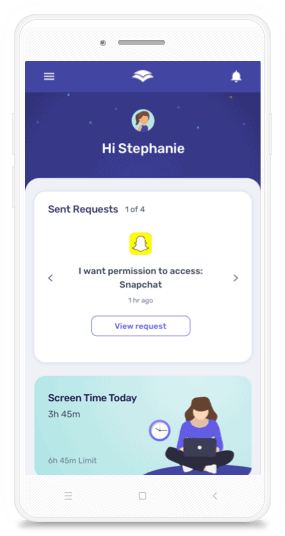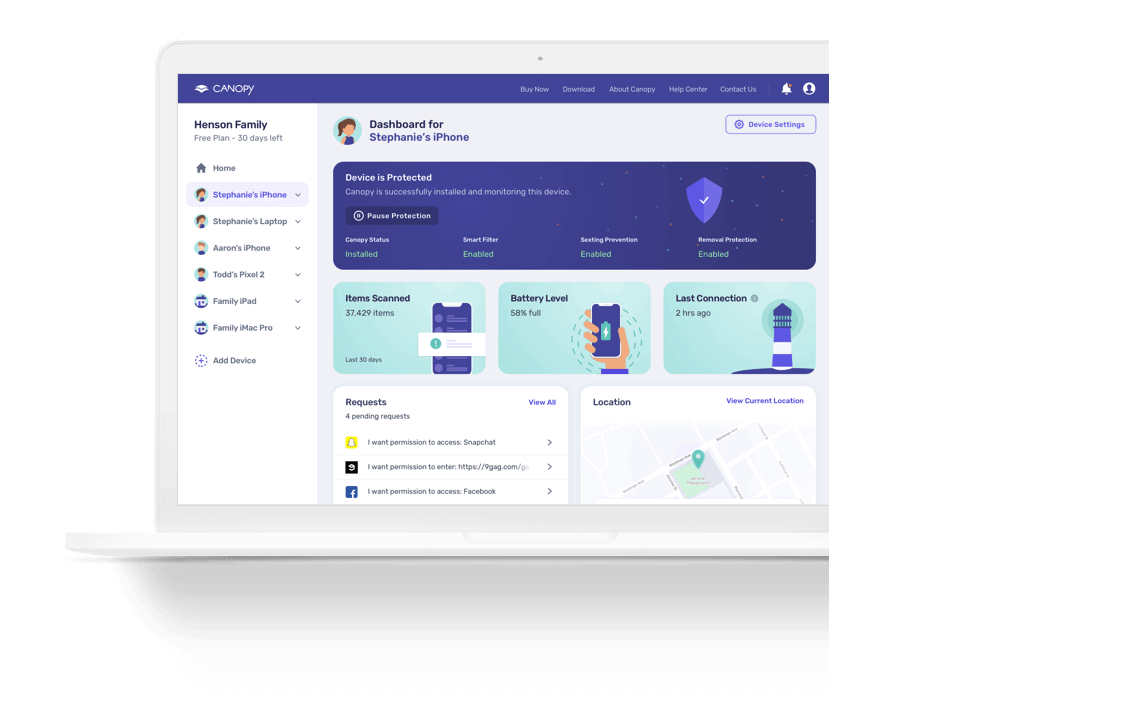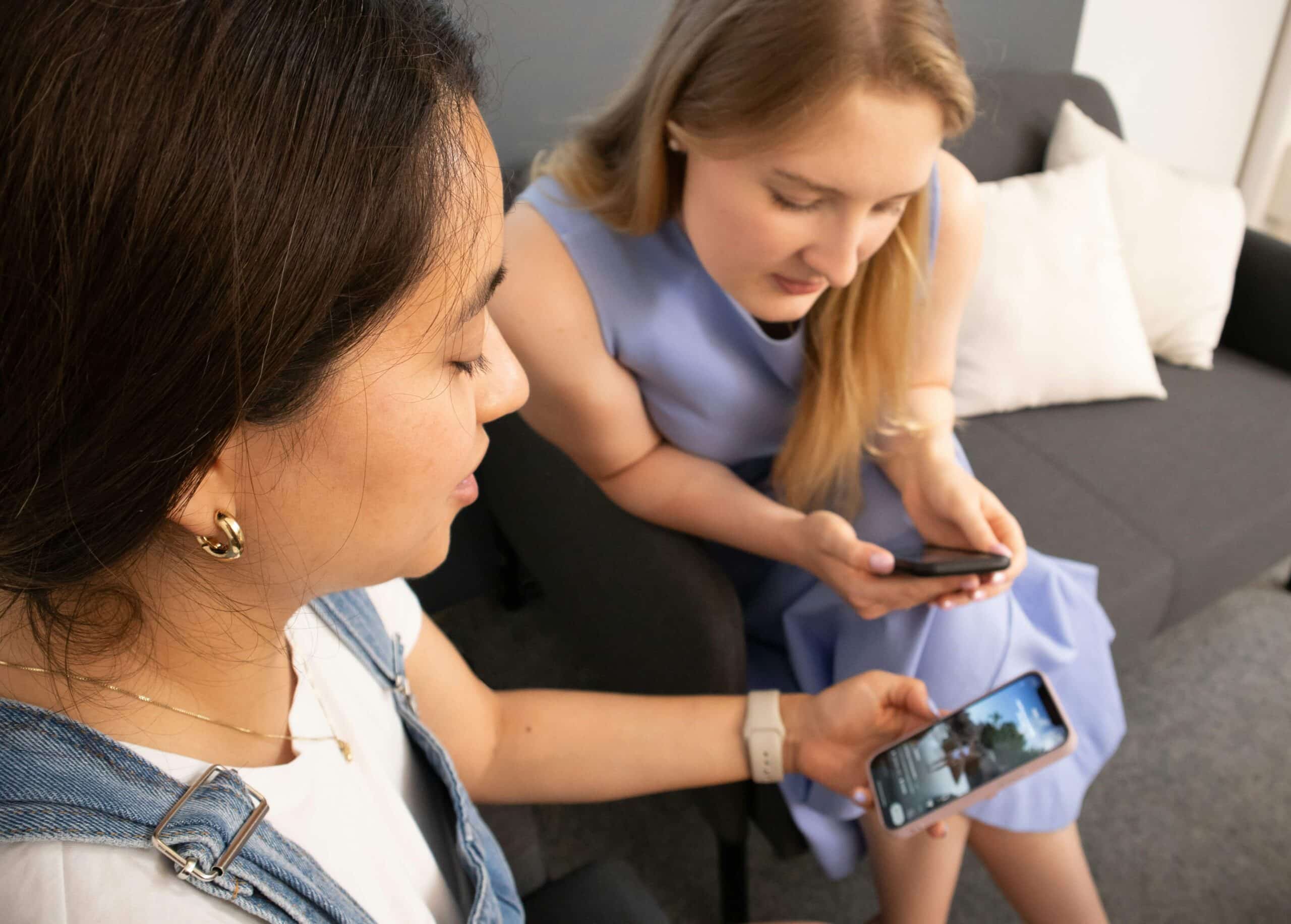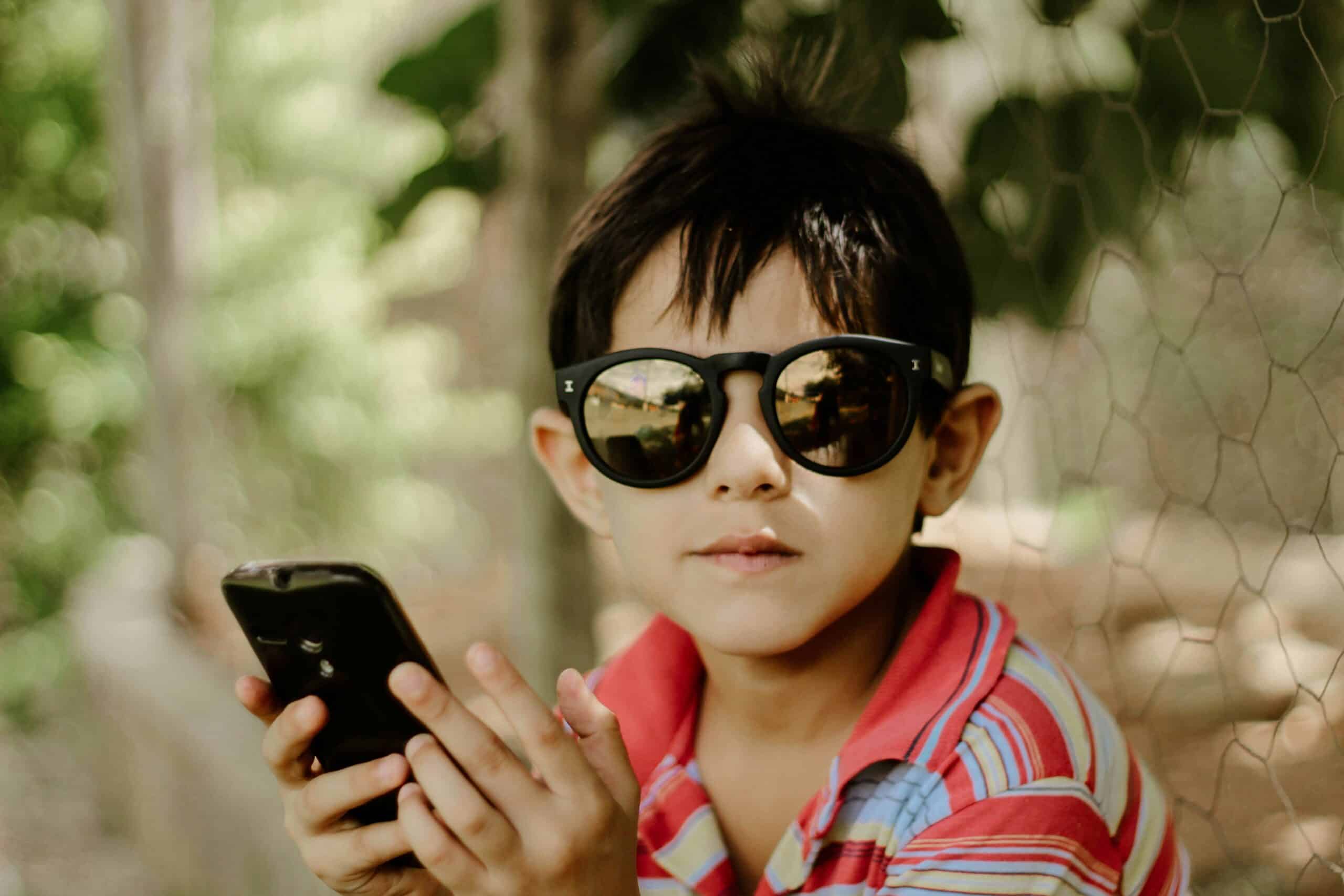Giving your 14-year-old their own phone presents a serious dilemma:
How do you keep them safe from the harms of the digital world while providing the independence, academic benefits, and social connection that cell phones offer?
And which phones strike the right balance?
These are not easy questions to answer, and we’re here to help.
In this article, we’ll share the 10 best phones for 14-year-olds.
But before we do, let’s answer some frequently asked questions from parents like you.
Frequently Asked | Read This Before Buying a Phone for Your Kids
Key considerations for parents
We’re going to kick off with a worrying statistic: 73% of teens have watched porn online — more than half of them by the age of 13.
Giving your teen a phone opens them up to a world of inappropriate content. But that’s not where the dangers end.
Teens are also vulnerable to the harmful effects of:
- Phone addiction (Study link)
- Cyberbullying and sexting (Study link)
- Social media, which includes comparison culture and the development of radical views (Study link)
Given all these risks, it’s no wonder parents hesitate to give their kids a phone.
But according to experts from the Harvard School of Education, there’s a lot we adults just don’t get about our kids’ relationships to their phones.
Better understanding how our teens feel about their online lives can help us respect their independence, keep them safe, and have the right conversations with them about their digital lives.
In their book “Behind Their Screens,” researchers Emily Weinstein and Carrie James share insights from a study of over 3,500 teens:
- Teens know how damaging phones can be, often expressing concerns like “TikTok is running my life.”
- Kids use their phones in various ways—some productively, others less so—highlighting the need for nuanced conversations about their online lives.
Weinstein and James argue it’s time to re-think our “us-versus-them” approach to teens and screens.
Instead, we should adopt an “us-and-them” mindset to connect with our teens and guide them toward healthy tech habits.
Getting your child their first phone is an excellent opportunity to discuss what excites and worries them about the digital world and how to navigate it responsibly.
Is it normal for a 14-year-old to have a phone?
Whether it’s “normal” for teens to have a phone is one question. Whether it’s common for them to have one is another.
Common Sense Media reports that by age 14, 91% of kids in the U.S. have a phone. In fact, not owning one can leave them feeling left out from their peer group.
14-year-olds these days are part of what Jean M. Twenge, PhD, calls “iGen” (born in the mid-1990s and later).
In her book, Twenge explores a generation that has had cell phones around them their whole lives.
She found that smartphones are central to how kids interact, learn, and explore their interests. They use them to socialize, stay informed, and satisfy their curiosity.
But as Twenge outlines, the average teen checks their phone more than eighty times a day. With stats like that, it’s not surprising that cellphone addiction has become so present in our societies that it has even got its own name — nomophobia.
So the next question is: how much screen time is right for a 14-year-old — and how can you help them limit it when it gets too much?
How much screen time is appropriate for a 14-year-old?
While screens can help teens learn, explore their interests, and stay connected, too much can lead to:
- Damage to their eye health (Study link)
- Depression, anxiety, and self-harm (Study link)
- Reduced physical activity and poor sleeping habits (Study link)
Samina Yousuf, MD, an OSF HealthCare pediatrician, says pediatricians generally recommend 5-17 years olds keep screen time down to two hours per day outside of homework.
The Australian Government Department of Health agrees. They say:
“For children and young people, we recommend no more than 2 hours of sedentary recreational screen time per day. This does not include screen time needed for school work.”
To help keep your kids safe from damaging effects of screen time, the Children’s Hospital Los Angeles recommends that you:
- Work with your teen to establish clear boundaries around screens.
- Come up with a family plan that outlines where they can use their screens, for how long, and which types of content they can have access to.
- Make sure they get adequate sleep (8-10 hours a day) and physical activity (more than one hour a day.)
Here are more resources to help you limit your kid’s screen time:
- The American Academy of Pediatrics’ free online Family Media Plan
- Common Sense Media’s Family Tech Planners
- 8 Best Screen Time Apps — Tested by us
- Should Parents Limit Screen Time?
What phone does a 14-year-old need?
The kind of phone that is appropriate for your child depends on the needs of your household.
You have three basic options when it comes to cell phones for teens:
- A smartphone with comprehensive parental controls in place
- A minimalist phone with limited or no connection to the internet
- A phone built for kids that comes with parental controls as part of the design
When making your decision, it’s important to note that not having a smartphone can be a source of stress for teens. In some cases, showing up with your basic flip phone to school can lead to bullying:
But, again, the story is complex. If they do get a smartphone, they can be on the receiving end of bullying too. As the American Psychological Association (APA) tells us:
“Bullying has been part of school, and even workplaces, for years. More recently, though, technology and social media have created a new venue for bullying that has expanded its reach.”
Yep — it can feel like you can’t win.
One of the APA’s key pieces of advice for parents is to set boundaries with technology. That doesn’t mean banning them from having a smartphone. Rather it means creating rules around cell phones and putting the right parental controls in place.
The easiest way to do this is to install a parental control app on your kid’s phone.
But not all parental control apps are created equal. Some are very basic, offering only screen time limits, while others come with AI-based Internet filters and sexting prevention.
In the next section, we’ll give you a checklist to help you choose the right one.
What to look for in the best parental control app – Checklist
To protect your child against any and every danger that lurks on the Internet, pick a parental control app that checks all these boxes:
- Lets you choose which websites, apps, and specific URLs you’d like to block or allow
- Filters out explicit content on all websites in real-time, before it reaches your kids’ device
- Prevents sexting by alerting you whenever an inappropriate image is taken or received
- Allows you to set Internet downtimes where your kids won’t be able to access the Internet
- Monitors Internet, app, and social media usage
- Tracks your kid’s location
- Prevents kids from removing the app from their device
- Is compatible with all your devices
💡Note: Our parental control app, Canopy, checks all these boxes. Sarah from Family Tech reviewed Canopy at length in this YouTube video.
10 Best Mobile Phones for 14-Year-Olds in 2024
Here are the best phones for 14-year-olds we’ll be reviewing, what they’re best for, and their features and costs.
Let’s dive in.
1. iPhone SE
Use it for: An affordable iPhone option with top-notch parental controls.
Overview:
The iPhone SE is a great starter iPhone for kids who really want an Apple device. It’s affordable, performs well, and comes with all the perks of an iPhone (like a great camera).
The iPhone SE is compact, which makes it easy for younger teens to handle. Its manageable size doesn’t sacrifice power, though—inside, it packs the A15 Bionic chip, the same processor used in higher-end models like the iPhone 13.
This means your teen can enjoy smooth performance whether they’re using an app for a school assignment, watching videos, or editing images.
Plus, with access to the App Store, they can download educational apps, productivity tools, and safe social media platforms, helping them stay organized and connected.
The 12MP camera allows your teen to capture high-quality photos and videos, which is perfect for school projects, hobbies, or just sharing moments with friends and family.
The camera also supports 4K video recording, making it a great tool for creative projects.
Why we like it:
The iPhone SE offers a blend of security, durability, and parental control features that make it an ideal choice for a 14-year-old’s first Apple phone.
It’s powerful enough to handle all of their needs—whether for school, communication, or entertainment—while also being easy to manage and protect.
Parental Controls:
With Apple’s Screen Time and Family Sharing features, you can set app usage limits, control who your child communicates with, and monitor their screen time. This gives you peace of mind while allowing your teen some independence.
But if you want more comprehensive parental control measures like blocking inappropriate content in real-time, Canopy is your best option.
Key Features:
- 4.7-inch Retina HD display
- A13 Bionic chip
- 12MP rear camera with Portrait mode, 4K video recording
- Water and dust resistant (IP67 rating)
- Fingerprint unlocking
- iOS 14
- Available in 64GB, 128GB, and 256GB models
Pros and Cons:
The iPhone SE is the best value deal if your kid wants an iPhone – it combines top-notch performance, excellent built-in parental control, strong battery life, and durability for an affordable price (especially if you get the refurbished ones from Amazon).
But the camera quality is low compared to more expensive iPhone models and Android phones of the same price.
Pricing: From $200 for refurbished, From $499 for new
Warranty: 2 year limited warranty
Plans and contracts: Unlocked. Set up with any 4G carrier or plan.
2. Google Pixel 8A
Use it for: A high-performing, Google-based smartphone with cutting-edge AI and safety features.
Overview:
A strong contender to the iPhone SE is the Google Pixel 8A — freshly released in May of 2024.
In fact, we think it’s even better than the iPhone due to its AI-driven camera, intelligent features, and built-in safety apps you can’t find on any other phones.
Here are the standout intelligent features:
- Google AI: Helps find information quickly by drawing a circle around images or text.
- Gemini Assistant: Helps brainstorm, summarize emails, write notes, and more.
- Live Translate: Translates signs, menus, and messages in real-time.
- Call Screen: Filters spam calls, making it easier to manage incoming calls.
- Clear Calling: Enhances call quality in noisy environments.
Plus, Google’s built-in parental controls, Google Family Link, allows you to manage screen time, decide which apps to block or allow, and monitor usage.
Beyond Family Link, the Pixel 8A comes with:
- Crisis alerts: Informs your kid of nearby hazards like flooding or fires.
- VPN by Google One: Secures your child’s online activity across apps and web browsers.
- Car Crash Detection: Calls emergency services automatically and shares your kid’s location in case of a severe accident.
Why we like it:
We love that the Pixel 8a is packed with Google’s cutting-edge AI features, perfect for teens who are budding content creators or who want to actively learn a new skill (like coding).
We also really appreciate the safety features that go beyond standard parental controls. The Car Crash Detection is especially incredibly useful as your kid starts to drive.
Parental controls:
Google’s Family Link app gives you robust parental controls right out of the box.
With Family Link, you can set screen time limits, approve or block app downloads, monitor app usage, and even track your child’s location.
However, it does not come with real-time content filtering and sexting prevention. Canopy is still your best option for this.
Other safety features include Crisis Alerts, VPN by Google One, and Car Crash Detection.
Pros and cons:
The pros of Pixel 8a includes its AI-powered camera that captures stunning photos and videos, long-lasting battery life that easily supports a full day of school and activities, and strong parental controls and safety features.
However, Pixel 8a has a higher price point compared to other mid-range phones, and you won’t be able to expand the storage capacity.
Pricing:
- Starts from $499
Warranty:
Google offers a standard 1-year limited warranty on all Pixel A series phones, covering manufacturing defects and issues with the hardware. You can also purchase additional coverage through Google’s Preferred Care, which extends the warranty and adds coverage for accidental damage.
Plans and contracts:
Pixel 8a is available unlocked, so you can choose any carrier or prepaid plan that fits your needs.
Most major carriers like Verizon, AT&T, and T-Mobile offer financing options, so you can spread the cost of the phone over time if you prefer.
3. Moto 5G
Use it for: An affordable option for a teen who wants to stream, listen, watch, and learn.
Overview:
Powered by Android, the Moto 5G is a great option for a high-performance smartphone at a lower price.
Your kids will be able to take great pictures, stream their favorite content, and listen to music in surround sound. As with the other smartphones on our list, they’ll also have access to popular messaging apps like WhatsApp and Messenger.
With its Snapdragon 480 5G platform, this phone is well-equipped to handle the adventures of curious children who love to use their phones to access educational apps, play games, and look up the answers to life’s most important questions.
Why we like it:
For the same price (if not less) as many of the dumb phones or flip phones on the market, the Moto 5G offers your child a great intro to the world of smartphones.
It has solid performance (even when multiple apps are open at once), great audio-visuals, and good battery life.
Your kids may also be happy that it comes with a free pair of Motorola earbuds—Moto Buds Plus.
Parental controls:
Motorola smartphones come with parental controls and safety settings that can be accessed through the free Google Family Link app.
However, this is limited to just setting screen time limits, blocking or filtering apps and websites, and location tracking.
If you’d like more comprehensive protection like real-time content filtering, you can install Canopy through Google Play Store.
Key Features:
- 6.7 inches Full HD+ (2520 x 1080 pixels), 90Hz refresh rate
- Qualcomm Snapdragon 765
- Rear Camera: Quad-camera setup (48MP primary, 8MP ultra-wide, 5MP macro, 2MP depth)
- Front Camera: Dual-camera setup (16MP primary, 8MP ultra-wide)
- 5G connection
- MediaTek Dimensity 7020 processor
- 128GB built-in storage with the option to add up to 1TB with a microSD
- Dolby Atmos (surround sound)
- Water-repellent coating
Pros and Cons:
With its vibrant display, 5G connection, and good battery life, the Moto 5G is a great phone to stream and play games on.
This is a pro and a con. While your kids will likely be thrilled, you will have to be vigilant about setting screen time limits. You can use either the built-in parental controls or Canopy to do so.
One of the major perks of going with Motorola is having access to Moto Care. It allows you to extend your standard limited warranty coverage or add additional coverage for accident damage. You can read about it here.
Pricing: $249.00
Plans and contracts: Unlocked. Check carrier compatibility here.
Warranty: Standard warranty which can be extended with Moto Care.
4. Samsung Galaxy A Series
Use it for: Affordable, mid-range, high-performance smartphones with built-in parental controls.
Overview:
The trusty Samsung Galaxy A series has a lot to offer teens for a reasonable price.
Many phones in this series are even cheaper than some dumb phones (like The Light Phone and Wisephone that we discuss below) and come with great cameras, long battery life, vibrant displays, and solid performance.
Here’s a summary breakdown of each phone in the A series:
- Galaxy A13: A budget-friendly option with a 6.5-inch display, quad-camera setup, and a long-lasting 5000mAh battery, perfect for basic tasks and casual use.
- Galaxy A14: An upgraded version of the A13, featuring a slightly improved processor and camera capabilities.
- Galaxy A15: Offers a 6.6-inch display with enhanced resolution, better camera quality, and faster processing power, suitable for multitasking and gaming.
- Galaxy A25: Comes with a 6.5-inch Super AMOLED display, quad-camera setup, powerful processor, and a 5000mAh battery, offering a balance of performance and affordability.
- Galaxy A32: A mid-range model with a 6.4-inch Super AMOLED display, superior camera system, and 5G connectivity.
And don’t let the image above fool you—each model in the series comes in many different colors like black, white, blue, red, green, and violet.
Why we like it:
For a similar price to many of the dumb phone options out there, you can get your child started on their journey of using a smartphone responsibly. It runs well (on a Mediatek 6835 processor) and offers reliable 5G internet.
They also offer Samsung Kids which offers some parental controls. Just note — your teen will likely feel that they’ve grown out of the educational content that Samsung Kids has to offer. (If you have younger kids, the cute, quirky characters can help them learn many new skills ranging from singing to coding.)
Parental Controls:
Samsung Kids offers some parental controls but does not include sexting prevention and AI filtering. For this, you’ll need Canopy.
Key Features:
- 5G connectivity which will allow teens to browse, connect and play without getting frustrated
- All the power of the Android OS
- AMOLED screen display that allows you to see your screen clearly indoors and outdoors
- Triple lens camera
- Up to 1TB storage space
Pros and Cons:
The battery life, storage, and user-friendliness of these phones are all noteworthy, considering the price.
Samsung offers trade-in credit deals so if you have an old Samsung that you’re no longer using, you can save on costs for your new Galaxy.
On the downside, it has a plastic build which can mean it heats up more easily. It’s also not waterproof — which I hope you don’t have to figure out the hard way.
Pricing: Depending on the retailer, you can expect to pay in the region of:
- Samsung Galaxy A13: $150
- Samsung Galaxy A14: $150-$170
- Samsung Galaxy A15: $199.99
- Samsung Galaxy A25: $200-$300
- Samsung Galaxy A32: $299.99
Warranty: 12-month brand warranty
Plans and contracts: Choose your plan through Verizon, AT&T, T-Mobile or UScellular or opt for Unlocked by Samsung which gives more freedom to choose.
5. Samsung Galaxy S Series
Use it for: Fast-performing phones for both school assignments and hobby projects.
Overview:
If you’re looking to get your child a high-end phone where they can learn, create, and connect, the Galaxy S Series is steps above average.
Your kids will appreciate the powerful performance of Galaxy S phones. Equipped with high-end processors and plenty of RAM, these phones can handle any task your child throws at them, without lag. This means smooth multitasking and a seamless user experience, whether they’re studying or playing.
The advanced cameras are perfect for kids who love taking photos and making videos, while the solid battery life means fewer worries about the phone dying during the day.
Here are our favorite phones in the series:
- Galaxy S21: A powerful and compact smartphone with a stunning display and advanced camera, perfect for teens who love photography and gaming.
- Galaxy S23 FE: A feature-rich phone offering flagship performance at a more affordable price, ideal for teens who want high-end features without breaking the bank.
- Galaxy S22 Ultra: A premium phone with a built-in S Pen and top-tier camera, making it great for creative teens who need a versatile device for both school and hobbies.
Why we like it:
The Samsung S series prides itself on being the “most used work device,” making it a state-of-the-art vehicle for teens curious about using their phones for school projects and assignments.
Samsung DeX allows you to transform your mobile phone into a workstation by connecting it to a laptop, TV, or monitor. Your kids will be able to seamlessly connect word-processing documents, spreadsheets, and presentations to other devices.
Parental Controls:
Samsung Galaxy S series phones do come with built-in parental controls which allow you to monitor screen time, set app limits, and track the phone’s location.
But if you want more comprehensive parental control measures like blocking inappropriate content in real-time, Canopy is your best option.
Key Features:
- Standard features of the Android OS
- Quad camera
- WiFi 6 (faster internet speeds — great for streaming)
- Samsung DeX
- Samsung Kids
- Samsung Knox protection
Pros and Cons:
The pros of this phone are multiple. Not only can it be used as a workstation but, with its quad camera, it’s a fantastic option for budding content creators.
It also supports Samsung Knox to protect your child’s phone against theft, data leaks, and hacking.
But those shiny features come with a price tag, both in terms of monetary value and risk. It’s vital that you have comprehensive parental controls with a robust filter and sexting prevention.
Pricing: Depending on the retailer, you can expect to pay between $350 and $450.
Warranty: 12-month brand warranty
Plans and contracts: Choose your plan through Verizon, AT&T, T-Mobile, or UScellular, or opt for Unlocked by Samsung which gives you more freedom to choose.
6. OnePlus Nord N30 5G
Use it for: A clean, fast, and durable smartphone.
Overview:
The OnePlus Nord N30 is an excellent mid-range smartphone that offers a blend of performance, design, and affordability.
Its vibrant display, strong performance, versatile camera, and long battery life cater to the needs of young users, while the clean software and ample storage make it practical for everyday use.
Running on OxygenOS based on Android, the Nord N30 provides a clean and user-friendly interface with minimal bloatware. The software is intuitive, making it easy for kids to navigate and for parents to manage.
Whether your child needs a reliable phone for school, entertainment, or staying connected, the OnePlus Nord N30 is a smart and stylish option.
Why we like it:
We love the look and feel of this phone. It’s sleekly designed and feels very sturdy — substantial style for the price point!
Parental Controls: Install Canopy to keep your kids protected.
Key Features:
- All the Android OS features
- SUPERVOOC Fast charging
- Up to 1TB expandable storage
- Headphone jack
Pros and Cons: The major perk of this phone is its ultra-fast charging capabilities. While that may seem like a gimmick, for teens who have fast-paced lives, it can be a necessity.
It’s currently available as a T-Mobile promotion, where you get the phone “free” when you sign up for a 24 month plan. Check out the deal here.
Pricing: $299 (or “free” on the T-Mobile promotion)
Warranty: 1 year manufacturer’s warranty.
Plans and contracts: Available through T-Mobile but possible to purchase unlocked.
7. CAT S22 Flip
8. The Light Phone
Use it for: A dumb phone without distracting apps or Internet browsers.
Overview:
If you don’t want to give your kid a smartphone, the Light Phone is a good option.
Originally designed for adults who want to “digital-detox”, it only has the essentials: calls, texts, and an alarm clock. No internet, no social media, no games—just simple and safe communication. You will love the peace of mind it offers, knowing your kids won’t be exposed to online dangers.
The latest offering, the Light Phone III has some extra features such as a camera and a faster processor. But if you’re looking for a phone with optimal user experience, this may not be it. (It’s made to limit use rather than promote it.)
Why we like it:
Like the Wisephone, the Light Phone has an e-ink screen which does not emit blue light (unlike most LCD or LED screens).
The jury is out on whether blue light is harmful to all of us but research suggests that excess exposure could harm eye health, particularly in “light-sensitive populations” such as young children and older people.
We also like that The Light Phone comes unlocked, meaning that you can use it with your current carrier or with Light Service, the company’s service plan.
Parental controls:
The Light Phone doesn’t come with any parental control features and you won’t be able to install a third-party app.
Key Features:
- Phone
- Text
- Voice to text
- Alarm
- Calculator
- QWERTY keyboard
- Flashlight
- Personal hotspot
- Bluetooth
- Headphone jack
Pros and Cons:
While the Light Phone is a good option when it comes to simplicity, that perk is also its potential downfall. Its connectivity and useability are unreliable and it can bug out occasionally.
Although it’s improved in the Light Phone III, the battery life is not great, adding to the potential unreliability. So, it’s not a perfect option when it comes to staying connected to your kids. We’d recommend it as training wheels but not for a long journey.
The Light Phone is also relatively expensive (starts from $300) for the very limited features it offers.
That being said, if you’re looking for a simple phone that can also be used as a hotspot for other devices, this is a good option.
Pricing:
- Light Phone II: $299
- Light Phone III: $799 (Pre-Order $399)
Warranty: The Light Phone can be returned within a year for manufacturer defects only.
Plans and contracts:
The Light Phone offers various service plans:
- $30 + tax / month (Unlimited calls and messages + 1 GB data)
- $45 + tax / month (Unlimited calls and messages + 5 GB data)
- $70 + tax / month (Unlimited calls, messages and data)
U.S. Light Phones come with a free SIM card. You can keep an existing number or get a new one.
The phone is unlocked so you can also use it with your current carrier.
9. Gabb Phone Pro
Overview:
The Gabb phone is specifically designed for kids to be safe while still enjoying some of the benefits of having access to apps that are kid-friendly, educational, and entertaining.
They offer age suggestions as follows:
- Gabb Phone 4: Suggested age — 9 to 13
- Gabb Phone 4 Pro: Suggested age — 14 to 18
So at age 14, the Gabb Phone 4 Pro is likely a good fit.
(If you’re unsure, however, Gabb offers this quiz on their website to help you decide what model is most suitable for your child.)
Noteworthy features include:
- Gabb Cloud (storage)
- Gabb Guard (a spam blocker)
- GabbMusic+, “the world’s largest kid-safe music library.”
Why we like it:
Gabb offers the chance for your kids to have a phone that looks and feels like an adult phone but is designed for kids.
They also have some notable parental control features. Our favorite is Gabb Messenger Parent which will notify you if nudity is detected on a video call.
Parental Controls: Built into the phone
Key Features:
- Unlimited talk and text
- GPS location services
- Gabb Messenger (unique messaging service)
- Gabb Music
- Camera and gallery
- Preinstalled apps such as a calculator, calendar, and notes.
- List of curated apps to choose from under categories such as “education” and “bible study”
Pros and Cons:
The Gabb phone is specifically designed for kids so provides a safer digital experience.
But there are downsides to be aware of — that your kids may let you know about. As they get older, they might be looking for a phone that gives them access to apps that allow them to use their phones as a place to socialize and work.
So while they may be ok with the Gabb phone for now, they may soon put the pressure on to get them a smarter, more adult phone.
Pricing:
- Gabb phone 4: $149.00 + Gabb Cellular Plan
- Gabb phone 4 Pro: $199.00 + Gabb Cellular Plan
Plan availability: Gabb plans range from $24.99 to $34.99. Month-to-month contracts are available.
Warranty: $4.99 / month (covers damage from drops and spills)
10. Pinwheel
Overview:
Pinwheel is an operating system designed specifically for kids that you can use with different types of phones and carriers.
If you want to keep your kids more digitally disconnected, Pinwheel’s OS can help you do so. It does not come with an Internet browser or social media.
It does come with safe, helpful apps out of the box, such as a calculator, flashlight, camera, and a vetted library of 1,000+ applications that you can add to your child’s device as needed.
Plus, parents get access to the Pinwheel Caregiver Portal where you can:
- Create a contact Safelist
- Monitor texts and calls
- Add or delete/restrict apps
- Manage screen time
- Track location
You can choose from five different phone types with Pinwheel OS already installed:
- Google Pixel 8A – for exceptional photo and video quality, fast speed for opening apps and images, and all-day battery life.
- Samsung Plus 4 – a premium smartphone with a minimum design and a durable build, perfect for your kids’ busiest days.
- Motorola Slim 6 – sleek, modern phone that is compatible with all major carriers, giving your child reliable technology at an affordable price.
- Rugged 3 – a durable smartphone for active kids who want extra protection from drops, dirt, and water.
- Genesis 1 – the cheapest option of all five.
Why we like it:
We like that Pinwheel offers the best of both worlds—your kids will get a stylish smartphone and you’ll get peace of mind knowing they can’t access internet browsers or social media.
You’ll also get full control over how you want to design your kid’s first phone. You can add-on apps that would benefit their learning or creativity (e.g. Duolingo for language learning), while restricting access to others like social media. You can even install an app like Zoom so they can attend online lessons.
And as your kid grows up, you can decide how and if to expand what they can access on their phone.
One key feature we love is the Focus Mode and scheduling. You can set specific times for different types of app access (e.g. educational apps during homework time, communication during after-school hours). This helps in creating a balanced routine for your child.
Parental controls:
Built into the phone and managed through their Caregiver’s Portal.
Key Features:
- Pre-vetted apps
- Screentime management
- Text and call monitoring
- Safelist of contacts
- GPS and location monitoring
- Parental control removal prevention
Pros and Cons:
The best thing about Pinwheel is that it comes with comprehensive parental controls.
However, the Caregiver Portal is not free — you’ll have to pay an additional subscription fee of $14.99/month for your kid’s first phone, and $4.99/month for every additional phone.
Some parents love the Caregiver Portal:
Others, not so much.
The Caregiver Portal also does not come with real-time content filtering. Canopy is still your best choice if you want to protect your kids from explicit content before they even see it in the first place.
Pricing:
- Genesis 1: $99
- Slim: $199
- Rugged 3: $249
- Plus (5G): $329
- Pixel 8A: $599
Plans and contracts: Works with most major carriers
Warranty: Standard manufacturer’s warranty, dependent on the specific phone’s manufacturer.
Best Phones for 14-Year-Olds – FAQs
Have more questions about the best phones for 14-year-olds? We answered them here:
What phone should a 14 year old get?
When choosing a phone for a 14-year-old, it’s important to balance functionality, safety, and durability.
A smartphone like the Google Pixel 8a or Samsung Galaxy S23 FE is a great choice because they offer robust parental controls, strong performance, and safety features like Google’s AI tools and Samsung’s secure environment.
These phones also provide a good mix of educational tools, entertainment options, and communication features without overwhelming your teen with unnecessary distractions.
Both models also come with long-lasting batteries and durable designs, so they can withstand the daily wear and tear of a teenager’s life.
Is 14 the right age to get a phone?
Fourteen is often considered a good age for a first smartphone, as many teens at this age are starting to become more independent and are engaging in more social activities, both in person and online.
A phone can help them stay connected with family and friends, manage their schoolwork, and explore interests like photography or music.
However, the right age really depends on your child’s maturity level and your family’s specific needs.
At 14, most teens are responsible enough to handle a phone, especially with the right guidance and parental controls in place.
This is also an ideal age to start teaching them about responsible phone use, online safety, and the importance of balancing screen time with other activities.
What features should I look for in a phone for a 14-year-old?
When selecting a phone for a 14-year-old, there are several key features to consider:
- Parental Controls: Ensure the phone has robust parental controls that allow you to monitor and manage your child’s usage.
- Durability: Look for a phone with a sturdy build or a good protective case, as teens can be rough on their devices.
- Battery Life: A long-lasting battery is essential to get through a full day of school, activities, and socializing.
- Camera Quality: A good camera is important for teens who enjoy photography or want to capture memories with friends.
- Performance: A phone with a decent processor and sufficient RAM ensures smooth operation for apps, games, and multitasking.
- Security Features: Features like fingerprint or facial recognition add an extra layer of security.
- Size and Display: A screen that is large enough for easy viewing but not too bulky for their hands.
- Price: Consider a phone that offers a good balance of features and price, so you get value without overspending.






